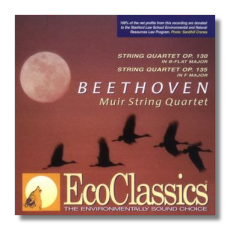
The Internet's Premier Classical Music Source
Related Links
- Beethoven Reviews
- Latest Reviews
- More Reviews
-
By Composer
-
Collections
DVD & Blu-ray
Books
Concert Reviews
Articles/Interviews
Software
Audio
Search Amazon
Recommended Links
Site News
 CD Review
CD Review
Ludwig van Beethoven

String Quartets #13 & 16
- Quartet #13, Op. 130 (1825)
- Quartet #16 in F Major, Op. 135 (1826)
Muir Quartet
 Peter Zazofsky, violin
Peter Zazofsky, violin
 Wei-Pin Kuo, violin
Wei-Pin Kuo, violin
 Steven Ansell, viola
Steven Ansell, viola
 Michael Reynolds, cello
Michael Reynolds, cello
EcoClassics 006
First of all, you should know that the Op. 130 does not include the Grosse Fugue. Just in case that means a lot to you. It is coupled on the other two discs in my collection [the Cleveland Quartet on Telarc and the Végh on Valois]. On the other hand, this disc does include the last composition Beethoven finished: the revised finale to Op. 130 as well as the last quartet.
How does the Muir stack-up with these two better known groups? Very well, thank you. Their sound is lighter, younger in interpretation. The Cleveland Quartet's sound is dark, rich, almost orchestral. They are also often slower (their first movement is almost a minute slower than Muir) deeper, the creation of someone older. The cello has a rasp to it that is almost 'woody' and it is more forward in the sound picture than in the Muir. The Végh Quartet also has a balance where the cello is more prominent and his sound is similar to the Cleveland's. The Végh is darker than the Muir, but not dark yet (to paraphrase a recent Dylan song). On the other hand, they change gears so that the playing is slightly faster after the opening of the first movement than in the Cleveland recording. As for sound, the Cleveland Quartet has a sound I personally prefer, the Végh is just slightly dated, the Muir has a pleasant, integrated sound.
I am now going to engage in a philosophic digression; you have been warned. Grahm Greene, in his novel poses the question: can you separate the singer from the song? I would like to carry this argument a step further and wonder if you can separate the recorded performance from the recorded sound? I much prefer the sound on the Telarc disc, it stimulates a pleasurable tickle in the back of my brain. This is a phenomenon I have noted before in reviewing. I do not understand it, but it is a fact that some recordings have this effect and others do not. This does not mean that a mediocre performance can be made good by virtue of the sound. On the other hand, it can contribute to a more favorable response in one performance over another. My introduction to classical music was via orchestral music, specifically Stokowski. I happen to prefer "The Stokowski Sound". As I learn more about my latest passion, chamber music, and instrumental, I often find I prefer the richer, more orchestral sound such as that in the Cleveland recording. So, if I express a preference for the Telarc recording, be aware of my preferences. I don't think you can separate the singer from the song, except as some intellectual exercise.
Okay, back to the Muir recording now that you have wisely skipped-over the in medias res post script. I really do like the Muir disc and hope they will record more quartets. I would love to hear them do the Schubert #15, Sibelius, any Dvořák. Though lighter and more lively than is my wont, I will return to this disc often as a valid, excellent if different alternative to the Cleveland and Végh.
You can get this disc by ordering directly from: EcoClassics PO Box 6834 Holliston, MA 01746. Cost is $15.00 post paid for the disc. You'll be glad you did and the profits go to conservation groups!!!
Copyright © 1998, Robert Stumpf II


















